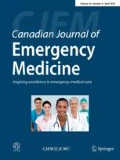Waiting is the most common patient experience in Canadian emergency departments (EDs): waiting for triage, waiting for registration, waiting for the doctor, and waiting for results. Waiting is the biggest part of most ED visits. Patients and physicians have diametrically opposite perspectives of the care process. While patients experience stasis, physicians experience flow, an insatiable demand for their service, running from patient to patient, constant stress, and never catching up. In fact, this mismatch between supply and demand is the core theme at the heart of the waiting game in Canadian healthcare.
The COVID-19 pandemic has challenged our system. The need for personal protective equipment (PPE) has added complexity and time to each patient encounter, and many EDs have initiated patient cohorting to isolate potential COVID positive patients. In this issue of the Journal, Odorizzi et al. describe the detrimental impact of streaming patients into hot and cold zones on patient flow, and how subsequent changes to the queuing process mitigated care delays and decreased patient length of stay [1].
This ED initially split its mid-acuity care area into a hot zone for patients with COVID-19 symptoms, where staff wore PPE, and a cold zone for other patients where PPE was optional. Because care spaces and physicians are critical bottleneck resources, this segmentation led to mismatches in the hot and cold zones between supply (care spaces, physicians) and demand (patients needing care). The result was prolonged patient waiting. At the same time, inadvertent staff exposures occurred in the cold zone where staff without PPE met patients with unrecognized COVID-19. In response, the department moved to a more efficient queuing process.
Staff maintained universal PPE, but switched from parallel hot/cold zones back to a single queue model. This brought all care spaces and physicians back into play for all patients (with appropriate stretcher cleaning measures). After physician assessment, “hot” and “cold” patients flowed to separate internal hot/cold waiting zones to reduce transmission risk. The elimination of dual assessment zones was associated with a 24-min reduction in patient length of stay. Segmentation after physician exam added to safety, but did not compromise flow, because “waiting areas” are not bottleneck resources.
This wait time improvement was entirely predictable. Shopping market style queues have customers line up in multiple discrete queues to access a specific person or service. This strategy works poorly in EDs where demand for specific services is unpredictable and unlikely to match a fixed split of care resources. Inevitably, demand and supply become mismatched. One stream backs up with too many patients, while providers sit idly on the other. Conversely, bank style queues direct customers into a single line toward the next available provider. Bank queues are advantageous in EDs, because they allow resources to be used optimally despite unpredictable demand.
Queuing theory is the study of the formation, function, and flow of waiting lines or queues using applied mathematics [2]. It helps us understand how patients arrive and flow through the ED, and how care processes and people can be optimized to meet demand [2, 3]. We often focus on the initial ED queue (e.g., time to MD), which is the most apparent, but patients experience many other queues during their stay. These are variable and more challenging to study. Odorizzi et al. describe a simple modification to front-end queuing that demonstrated a substantial reduction in length of stay. This illustrates that, although EDs are highly complex systems, attention to queuing processes can significantly improve flow and that queuing theory is highly relevant to ED process improvement.
Process change within complex systems can have unexpected safety impacts. Although these authors describe precautions such as physical distancing and PPE in both the initial and the modified flow approaches, they did not report safety data, and it is important to monitor safety and other system metrics when process changes are made. In this case, nosocomial infection rates would be of interest, as would other ED crowding metrics including left without being seen rates, ED waiting times, occupancy, boarding time, and 72-h bounce-back rates [4].
Waiting is the predominant activity experienced by most patients during an ED visit. This study shows the value of applying queuing theory in mitigating those waits and understanding the anticipated impacts of any proposed flow modification. Ongoing process monitoring and thoughtful process optimization can have beneficial impacts, decreasing both patient waiting time and production pressure on ED staff.
References
Odorizzi S, Clark E, Nemnom MJ, et al. Flow impacts of hot/cold zone infection control procedures during the COVID-19 pandemic in the emergency department. Can J Emerg Med. 2022. https://doi.org/10.1007/s43678-022-00278-0.
Joseph JW. Queuing theory and modeling emergency department resource utilization. Emerg Med Clin North Am. 2020;38(3):563–72. https://doi.org/10.1016/j.emc.2020.04.006.
Wiler JL, Griffey RT, Olsen T. Review of modeling approaches for emergency department patient flow and crowding research. Acad Emerg Med. 2011;18(12):1371–9. https://doi.org/10.1111/j.1553-2712.2011.01135.x.
McRae AD, Rowe BH, Usman I, Lang ES, Innes GD, Schull MJ, Rosychuk R. A comparative evaluation of the strengths of association between different emergency department crowding metrics and repeat visits within 72 hours. CJEM. 2022;24(1):27–34. https://doi.org/10.1007/s43678-021-00234-4.
Author information
Authors and Affiliations
Corresponding author
Ethics declarations
Conflict of interest
The authors have no conflicts of interest relating to this publication.
Rights and permissions
About this article
Cite this article
Johnston, A., Lang, E. & Innes, G. The waiting game: managing flow by applying queuing theory in Canadian emergency departments. Can J Emerg Med 24, 355–356 (2022). https://doi.org/10.1007/s43678-022-00318-9
Received:
Accepted:
Published:
Issue Date:
DOI: https://doi.org/10.1007/s43678-022-00318-9

